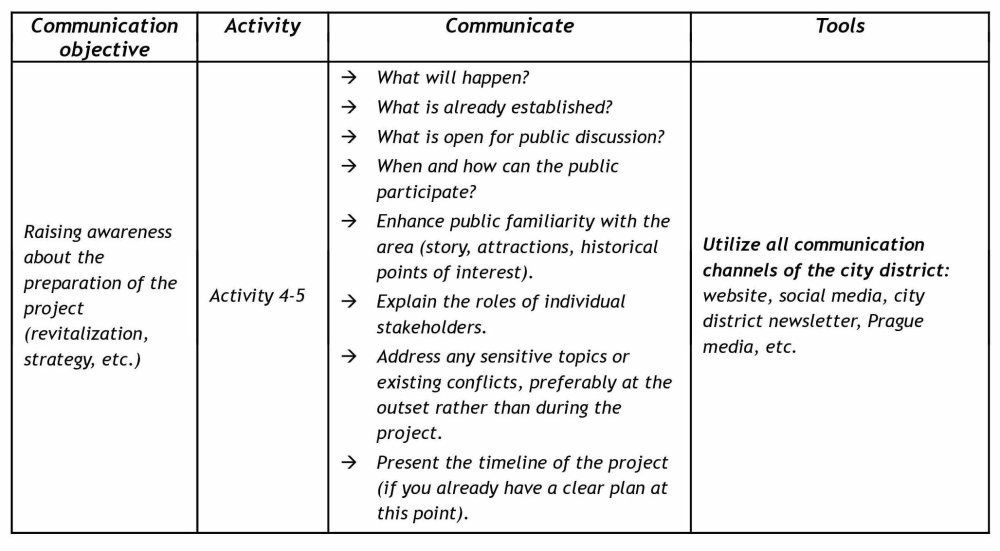
Activity 04 - Community and User Mapping
4.1 Description and objective of the activity
In Activity 4, our goal is to map individuals and organizations directly impacted by the project. This typically includes residents and commuters in the relevant area and its surroundings, entrepreneurs, service providers and their employees, visitors, tourists, as well as representatives from active civic initiatives and associations in the area advocating for specific interests.
Additionally, this may encompass individuals/organizations interested in the topic even if not directly affected, such as those addressing environmental or transport issues, local city district's employees (e.g., MA21 coordinator), cultural organizations interested in public space revitalization, chambers of commerce, and other professional associations. Moreover, we can invite others whose involvement is deemed beneficial, such as experts, specialists, longtime residents, local historians, ornithologists, etc.
The objective is to identify user groups affected by the project, comprehend their interests, recognize potential conflicts, and, based on this information, subsequently engage or mobilize them in the participatory process.
4.2 Responsible person
Planning Coordinator of the City District
4.3 Who to contact
- IPR Participation Office - support in project planning and community mapping (consultation)
- City district's or City of Prague's Departments (relevant offices and persons according to the nature of the project for consultation)
4.4 Individual steps (recommended)
A. Review existing documents
Review existing documents related to mapping, typology of users and the needs of individual communities within the city district or the project area. This may involve examining demographic studies, previous strategic or action plans, sociological surveys, or meeting minutes/reports from past community meetings, community mapping exercises, and projects in the vicinity (in the Czech Republic, e.g. Healthy Cities, MA21, participatory budgeting, individual participatory or planning projects).
B. Conduct a workshop with city district's / City of Prague's employees
After collecting and reviewing the existing documents, invite relevant departments (social, environmental, cultural, transportation, education, etc.) and organize a small workshop with them. Consider inviting employees from the city district who reside in the project area or are involved in the project topic, even if they are not from the specified departments (please inquire with colleagues).
During the workshop, collaborate with the participants to identify groups of residents, business owners, organizations and institutions, civic groups and service providers with whom they interact directly and are relevant to the project. This process enables you to thematically or territorially define the target groups affected by the project. Lastly, compile a list of all user groups that should be involved in the participatory process, including contact information and the areas (thematic, territorial) on which they have relevant input.
C. Field interviews
After the workshop, reach out to representatives of each user group, preferably in person through semi-structured interviews. These one-on-one meetings will provide insight into the local dynamics, their perspectives on collaboration with the city district/City of Prague or other entities, relationships among the groups, as well as their interests and needs (both project-related and general). For complex projects or those requiring it, consider outsourcing field mapping (e.g. anthropological survey). Consult with IPR for assistance in developing a commission brief for potential contractors.
D. Prepare outputs
Prepare the first draft of the community map (output 4A) and the list of communities (output 4B) and send them to IPR for review.
E. IPR Review
Within one week, the IPR Participation Office will provide feedback or recommendations for refinement.
4.5 Outputs of this activity (recommended)
Examples of outputs for inspiration; not all are mandatory:
- Output 4A: Community map
- Output 4B: List of communities - contact information and description
4.6 Budget
All expenses, such as refreshments, equipment rental and office supplies, will be covered by the resources of the city district/City of Prague. If needed, community mapping can be outsourced using the planning coordinator's budget.
4.7 Timeframe (indicative)
Typically within 3 weeks, longer for more complex projects.
4.8 Note of caution
Field interviews will enable you to complement the list of communities with user groups that may have been omitted in the workshop for various reasons. This process provides insight into how the community of a given place is viewed from the “bottom-up”.
Communication and interviews with local actors sometimes resemble detective work, requiring the filtering and further investigation of certain views to be verified. Beware that in addition to the interests and needs of the community, certain focal persons may also promote their personal interests or opinions.
4.9 Communication guidelines (indicative)

4.10 Parallel activities
You may implement Activities 1 - 3 concurrently with Activity 4.
